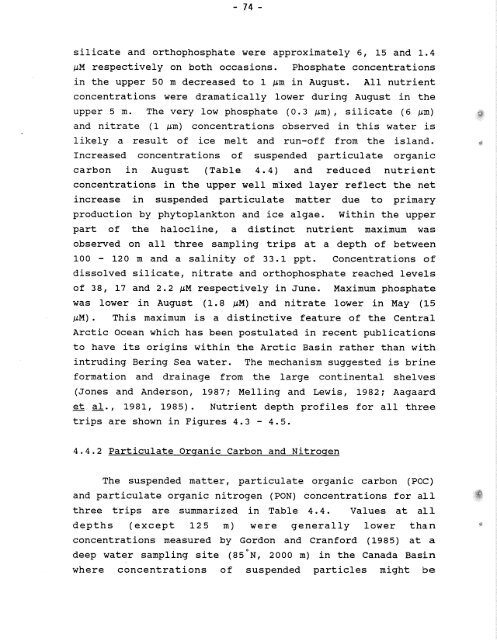Distribution of Chlorinated Hydrocarbon Pesticides and PCBs in the ...
Distribution of Chlorinated Hydrocarbon Pesticides and PCBs in the ...
Distribution of Chlorinated Hydrocarbon Pesticides and PCBs in the ...
Create successful ePaper yourself
Turn your PDF publications into a flip-book with our unique Google optimized e-Paper software.
silicate <strong>and</strong> orthophosphate were approximately 6, 15 <strong>and</strong> 1.4<br />
pM respectively on both occasions. Phosphate concentrations<br />
<strong>in</strong> <strong>the</strong> upper 50 m decreased to 1 pm <strong>in</strong> August. A11 nutrient<br />
concentrations were dramatically lower dur<strong>in</strong>g August <strong>in</strong> <strong>the</strong><br />
upper 5 m. The very low phosphate (0.3 pm) , silicate (6 pm)<br />
<strong>and</strong> nitrate (1 pm) concentrations observed <strong>in</strong> this water is<br />
likely a result <strong>of</strong> ice melt <strong>and</strong> run-<strong>of</strong>f from <strong>the</strong> isl<strong>and</strong>.<br />
Increased concentrations <strong>of</strong> suspended particulate organic<br />
carbon <strong>in</strong> August (Table 4.4) <strong>and</strong> reduced nutrient<br />
concentrations <strong>in</strong> <strong>the</strong> upper well m-ixed layer reflect <strong>the</strong> net<br />
<strong>in</strong>crease <strong>in</strong> suspended particulate matter due to primary<br />
production by phytoplankton <strong>and</strong> ice algae. With<strong>in</strong> <strong>the</strong> upper<br />
part <strong>of</strong> <strong>the</strong> halocl<strong>in</strong>e, a dist<strong>in</strong>ct nutrient maximum was<br />
observed on all three sampl<strong>in</strong>g trips at a depth <strong>of</strong> between<br />
100 - 120 m <strong>and</strong> a sal<strong>in</strong>ity <strong>of</strong> 33.1 ppt. Concentrations <strong>of</strong><br />
dissolved silicate, nitrate <strong>and</strong> orthophosphate reached levels<br />
<strong>of</strong> 38, 17 <strong>and</strong> 2.2 pM respectively <strong>in</strong> June. Maximum phosphate<br />
was lower <strong>in</strong> August (1.8 pM) <strong>and</strong> nitrate lower <strong>in</strong> May (15<br />
pM). This maximum is a dist<strong>in</strong>ctive feature <strong>of</strong> <strong>the</strong> Central<br />
Arctic Ocean which has been postulated <strong>in</strong> recent publications<br />
to have its orig<strong>in</strong>s with<strong>in</strong> <strong>the</strong> Arctic Bas<strong>in</strong> ra<strong>the</strong>r than with<br />
<strong>in</strong>trud<strong>in</strong>g Ber<strong>in</strong>g Sea water. The mechanism suggested is br<strong>in</strong>e<br />
formation <strong>and</strong> dra<strong>in</strong>age from <strong>the</strong> large cont<strong>in</strong>ental shelves<br />
(Jones <strong>and</strong> Anderson, 1987; Mell<strong>in</strong>g <strong>and</strong> Lewis, 1982; Aagaard<br />
- et &., 1981, 1985). Nutrient depth pr<strong>of</strong>iles for all three<br />
trips are shown <strong>in</strong> Figures 4.3 - 4.5.<br />
4.4.2 Particulate Orsanic Carbon <strong>and</strong> Nitrsqen<br />
The suspended matter, particulate organic carbon (POC)<br />
<strong>and</strong> particulate organic nitrogen (PON) concentrations for a%P<br />
three trips are summarized <strong>in</strong> Table 4.4. Values at all<br />
depths (except 125 m) were generally lower than<br />
concentrations measured by Gordon <strong>and</strong> Cranford (1985) at a<br />
deep water sampl<strong>in</strong>g site (85'~, 2000 m) <strong>in</strong> <strong>the</strong> Canada Bas<strong>in</strong><br />
where concentrations <strong>of</strong> suspended particles might be

















